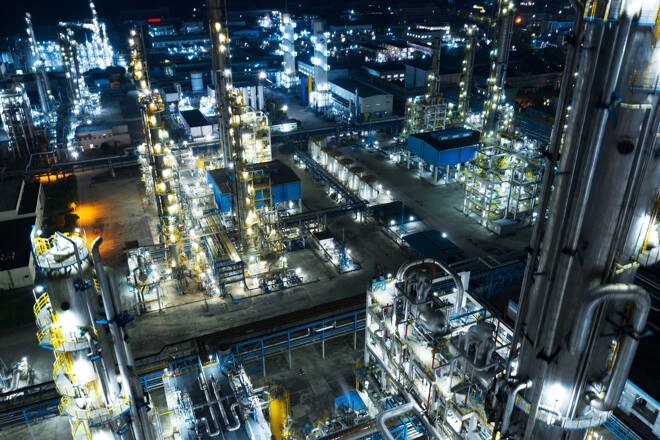Advertisement
Advertisement
Energy Annual Market Recap – 2019
By:
Energy markets saw diverging directions during 2019. While WTI crude oil rallied nearly 27% in 2019, Natural gas prices were on the defensive. Petroleum markets focused on international production, led by declines in OPEC crude output, while US production of natural gas surged, putting downward pressure on prices.
Looking forward, US crude oil production is expected to increase but decelerate relative to 2019, while all eyes will focus on whether OPEC+ will be able to adhere to their self-imposed production cuts. Natural gas investors will need to determine if low prices will reduce production, as demand remains stable and dependent on the weather.
Petroleum Market Recap 2019
Crude oil prices rebounded at the beginning of January and continued to grind higher after declining during the last month of 2018. Fear of a decline in demand in conjunction with overproduction led to an oversold condition in prices which was offset with a snapback in early 2019.
The rebound in prices followed a surge in OPEC+ production in late 2018 as investors took stock of Iranian sanctions. Initially, investors needed to wrestle with rising US production which ended 2019 at 12.8 million barrels a day rise of 1.2 million barrels a day according to the Energy Information Administration.
US Production Will Continue Rising
US crude oil production peaked slightly above 13.0 million barrels a day in 2019 and is expected to climb in 2020. The EIA forecasts that US crude oil production will average 13.2 million barrels in 2020, an increase of 0.9 million barrels a day from the 2019 level. While US production remains robust, the EIA forecast reflects a deceleration in growth on average. 2019 growth levels were 1.3 million barrels a day and 2019 growth levels were 1.6 million barrels a day. The slowdown in growth forecasted by the EIA is based on a decline in drilling rig activity over the past year that is expected to continue into 2020.
All Eyes are on OPEC Plus Additional Producers
To offset rising US production, OPEC+ has continued to manage exports. On December 6, OPEC+ announced larger production cuts originally announced in December 2018. The group is now targeting production that is 1.7 million barrels per day lower than in October 2018, compared with the former target reduction of 1.2 million barrels a day. OPEC announced that the cuts would be in effect through the end of March 2020.
The question is whether this will be extended especially if OPEC+ sees rising oil inventories due to lack of global demand. The EIA forecasts OPEC crude oil production will average 29.3 million barrels a day in 2020 down 500,000 barrels a day compared to 2019. Following this announcement, WTI oil prices rose nearly $6 per barrel from approximately $55 per barrel in late November to $60.75 in late December.
Prices and Sentiment
Oil prices are hovering slightly above the middle of the past 14-month range which saw prices rise to $76 per barrel in October of 2018 and the lows seen near $42 per barrel in December of 2018. Sentiment has been driven by OPEC+, as well as President Trump who has attempted to manipulate the oil markets by jawboning. Many of his tweets have been directed at OPEC+ who he implores to produce more oil to keep prices stable. Ahead of the 2020 elections, investors should expect President Trump to step up his rhetoric to keep gasoline prices capped.
Natural Gas Continues to Trade on the Defensive
Natural gas prices started 2019 trading on the defensive and continued to experience a downtrend for most of the year. Strong production and stable demand lead to rising inventories which drove prices lower. While there were a few hurricane-related spikes in prices, strong production weighs on prices pushing them to 2019 lows during the Q4 of 2019.
Production Remains Robust
Natural gas production was robust in 2019 rising 10% according to the Energy Information Administration (EIA). The EIA estimates that production rose on average to 92.1 billion cubic feet per day in 2019. Expectations are that production will grow at a slower pace in 2020 given the decline in prices and future drilling activity from E&P companies given the decline in prices. The EIA forecasts natural gas production in 2020 will average 95.1 Bcf per day.
Inventories are Rising
The key to the price of natural gas will be the trajectory of inventories during the winter. The EIA estimates that the total working gas inventories were 3,616 billion cubic feet (Bcf) at the end of November. This level was about equal to the five-year (2014–18) average and 19% higher than a year ago.
EIA expects storage withdrawals to total 1.9 trillion cubic feet (Tcf) from the end of October to the end of March, which is less than the five-year average winter withdrawal. Withdrawals of this amount would leave the end-of-March inventories at almost 1.9 Tcf, which would be 8% higher than the five-year (2015–19) average. If there is no change in this trajectory, prices will remain under pressure.
Looking forward price action could remain volatile. High levels of export have changed the dynamic for natural gas and could be the impetus the raises prices. If LNG exports pick up, production will likely be accelerated keeping prices capped domestically. Natural gas is priced relative to oil outside the US providing a large cushion for US LNG exporters.
About the Author
David Beckerauthor
David Becker focuses his attention on various consulting and portfolio management activities at Fortuity LLC, where he currently provides oversight for a multimillion-dollar portfolio consisting of commodities, debt, equities, real estate, and more.
Advertisement
